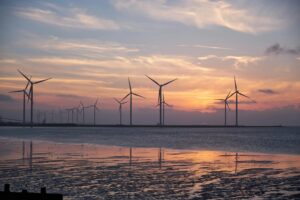 The draft of New York’s Clean Energy Standard Biennial Review was published July 1 by New York State Department of Public Service (NYS DPS) and New York State Energy Research and Development (NYSERDA). It illuminates the challenge ahead for New York to meet the clean energy goals of the Climate Leadership and Community Protection Act (CLCPA), including the 9,000 MW target for offshore wind by 2035.
The draft of New York’s Clean Energy Standard Biennial Review was published July 1 by New York State Department of Public Service (NYS DPS) and New York State Energy Research and Development (NYSERDA). It illuminates the challenge ahead for New York to meet the clean energy goals of the Climate Leadership and Community Protection Act (CLCPA), including the 9,000 MW target for offshore wind by 2035.
The report estimates that New York’s sole operational offshore wind farm, South Fork Wind Farm, which began delivering power to the grid in December of 2023, will annually deliver 464 GWh of power (operating at 53 MW, below its full capacity). Even with South Fork functioning at its full capacity of 130 MW, New York is left 8,870 MW away from the 9,000 MW target. The scale of development necessary to meet this target is daunting. The draft Biennial Review reports that supply chain constraints, inflation, rising interest rates, scarcity of high-voltage direct current cables, and changes to the cost of capital and inputs challenge offshore development projects. In its 2022 solicitation NYSERDA awarded preliminarily awarded contracts to three offshore wind farms that would have provided 4,000 MW of capacity, but on June 7, 2023, the developers submitted petitions to the New York State Public Service Commission requesting amendments to their contracts outside of the competitive solicitation process, citing increased capital costs, high inflation, and supply chain bottlenecks. These petitions were denied, leading to the cancellation of all projects in October of 2023. In light of this attrition, New York Governor Hochul announced in October a 10-Point Action Plan to affirm the State’s commitment to and provide clear benchmarks for renewable energy development, including an expedited competitive solicitation process announced by New York State Energy Research and Development Authority (NYSERDA) in November. However, macroeconomic factors continue to impact the profitability and therefore development prospects of American offshore wind. In January, the contract of Empire 1’s sister project, Empire Wind 2, was terminated with NYSERDA, due to developer’s concerns about inflation, interest rates, and supply chain disruptions.
In the month preceding the release of the draft Biennial Report, New York State and New York City announced actions that represent much-needed incremental progress towards the State’s offshore wind goals. Governor Hochul announced on June 4, 2024 the finalization of contracts for Sunrise Wind, which would be the nation’s largest offshore wind farm, and Empire Wind 1, which would be the first offshore wind farm to connect directly to the New York City grid. Sunrise Wind, a 924 MW project developed by Ørsted and Eversource, and Empire Wind 1, a 810 MW project developed by Equinor, together would supply 1,700 megawatts (MW) of power.
This would provide the capacity to power 1 million New York homes, immediately create 800 jobs, and provide $6 billion in economic benefits through in-state spending during the projects’ 25-year lifespan. With a weighted average all-in development cost of $150.15 per MWh, these projects would provide power on par with current market prices, increasing New Yorkers’ energy bills by approximately $2 a month. The projects were first selected during New York’s first offshore wind solicitation in 2019, but developers successfully re-bid the projects in the 2023 solicitation process. Their new contracts include a mechanism to account for inflation and the sharing of interconnection costs, but the over two fold increase in the residential bill impact of these developments from the 2019 to 2024 contracts evidences the impact of continued stress on American offshore industry. The updated contracts also obligate the companies to provide additional community benefits, with Eversource alone to direct $32 million to disadvantaged communities in community-focused investments and $16.5 million towards wildlife and fisheries monitoring.
To enable the future expansion of offshore wind infrastructure, New York City Mayor Eric Adams announced on June 10 that the South Brooklyn Marine Terminal will soon seat the nation’s largest offshore wind port. The Marine Terminal will host the operations and maintenance hub for Empire 1, a substation to connect the project into the grid through the Gowanus Substation, and a charger for the first plug-in hybrid vessel to be used in the U.S. offshore wind industry. This project is part of Mayor Adams’s Harbor of the Future Plan and Green Economy Action Plan, and is a deliverable of New York City’s 15-year, $191 million Offshore Wind Vision Plan that began in 2021. To prepare New Yorkers for employment in future offshore wind projects, the Mayor’s announcement said that the City and Equinor are funding initiatives such as apprenticeship programs and skill-building courses. The State has pledged $77 million to develop the offshore wind workforce and the labor agreement of the Empire Wind project also prioritizes the hiring of hyperlocal union workers from the Sunset Park area.
The 2024 offshore solicitation process is currently underway and awards will be announced Q1 of 2025. The State is working to support the development of grid connection and assured material supply for the future offshore wind industry. On April 23, 2024, NYSERDA released New York’s first solicitation focused exclusively on developing the offshore wind supply chain, seeking to award $200 million in grant funding for port infrastructure and manufacturing facilities.
The Public Service Commission has initiated a Public Policy Transmission Need Process, where they will identify transmission development needs required to comply with a law, regulation, or rulemaking order. Interested entities propose solutions to address this need, and an evaluation process results in transmission development. In June 2023 the Commission announced a Public Policy Transmission Need (PPTN) for infrastructure to integrate at least 4,770 MW of offshore wind into the New York City grid.
Even with Sunrise Wind and Empire Wind 1, New York still requires 7,170 MW more of offshore wind development in the next nine years to meet the 9,000 MW CLCPA target. Considering the attrition that occurred in 2023, the draft Biennial Report suggests that it may be necessary for NYSERDA to contract more than 7,170 MW over the next two solicitations, NY5 and NY6, the first starting this summer. These solicitations will seek projects that can be deployed by 2030, and the report finds that each project should provide approximately 14,048 GWh (1603 MW) of power, or, accounting for a predicted 30% attrition rate, 20,068 GWh per project (2,290 MW).

Anne Sappenfield
Anne Sappenfield is a Sabin Center Summer Intern, and a rising senior at Barnard College studying Political Science with a concentration in International Relations. Anne has worked on climate policy for California State Senator Josh Becker for two summers, and spent this spring engaged on a project to decarbonize steel used in Ørsted’s offshore wind turbines.




